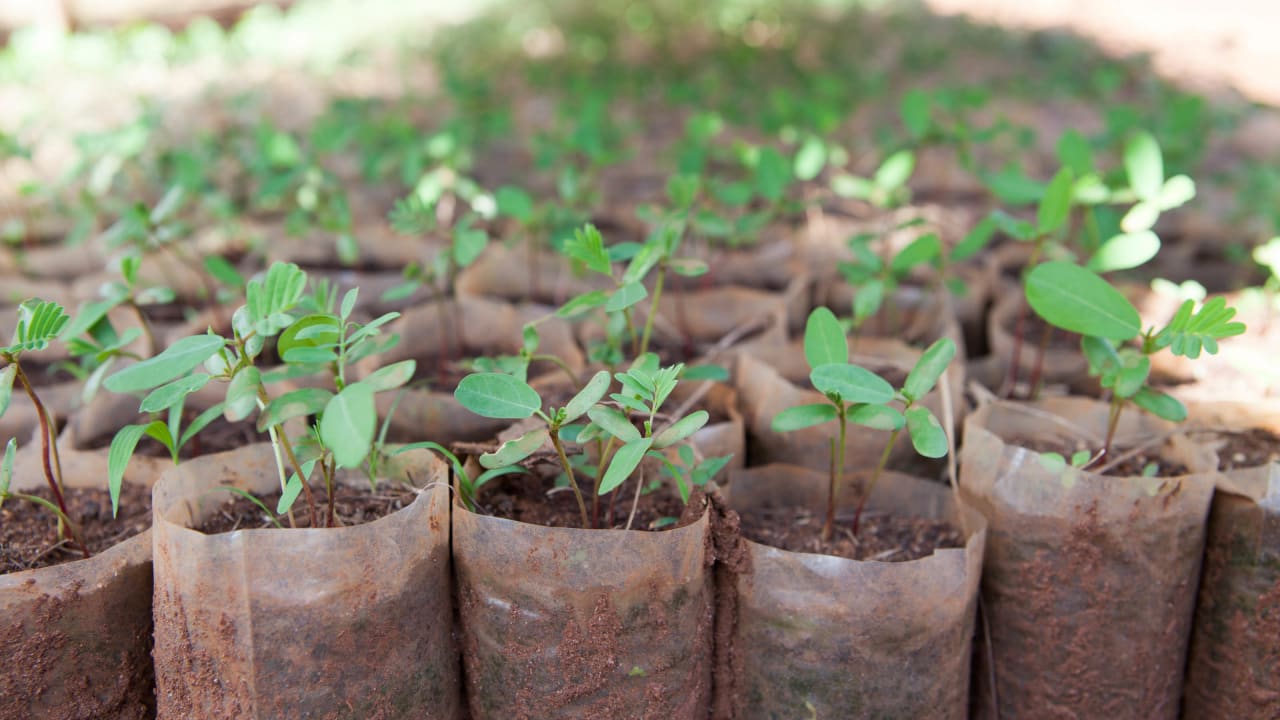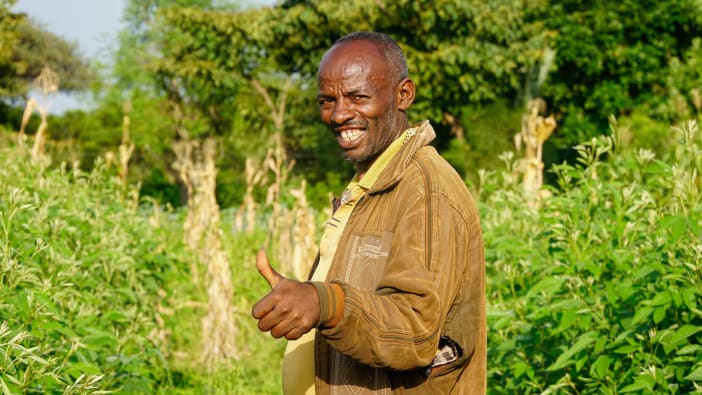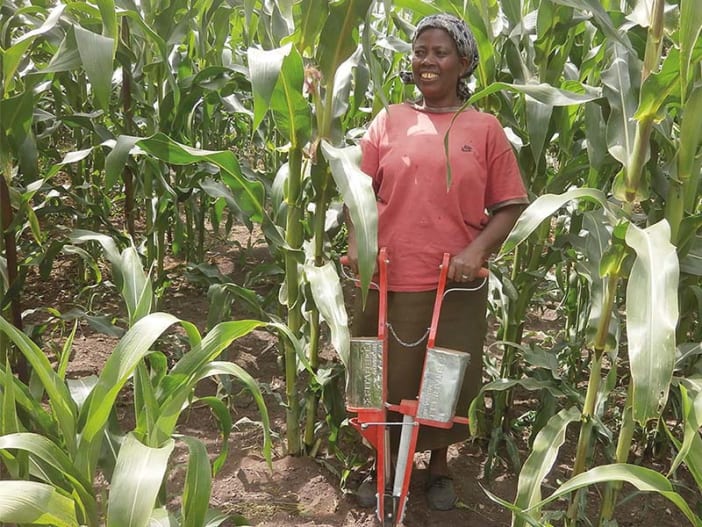- Cover methods
These methods all protect the soil from the damaging effects of rain-drop impact. Most will also improve soil fertility.
Mulching
Bare soil between growing plants is covered with a layer of organic matter such as straw, grasses, leaves and rice husks - anything readily available. Mulching also keeps the soil moist, reduces weeding, keeps the soil cool and adds organic matter. If termites are a problem, keep the mulch away from the stems of crops.Cover crops and green manures
Cover crops are a kind of living mulch. They are plants - usually legumes - which are grown to cover the soil, also reducing weeds. Sometimes they are grown under fruit trees or taller, slow maturing crops. Sometimes they also produce food or fodder. Cowpeas, for example may be used both as a cover crop and a food crop.Green manures - also usually legumes - are planted specially to improve soil fertility by returning fresh leafy material to the soil. They may be plants that are grown for 1-2 months between harvesting one crop and planting the next. The leaves may be cut and left on the surface of the soil as a mulch or the whole plant dug into the soil. Green manures may also be trees or hedges which may grow for many years in a cropping field from which green leaves are regularly cut for use as mulch (alley cropping).
Mixed cropping and inter-cropping
By growing a variety of crops - perhaps mixed together, in alternate rows, or sown at different times - the soil is better protected from rain splash.Early planting
The period at the beginning of the rainy season when the soil is prepared for planting, is when the damage from rain splash is often worst. Sowing early will make the period when the soil is bare, as short as possible.Crop residues
After harvest, unless the next crop is to be immediately replanted, it is a good idea to leave the stalks, stems and leaves of the crop just harvested, lying on the soil. They will give some cover protection until the next crop develops.Agroforestry
Planting trees among agricultural crops helps to protect the soil from erosion, particularly after crops are harvested. The trees will give some protection from rain splash. Fruit, trees, legume trees for fodder or firewood and alley cropping all help reduce soil erosion.Minimum cultivation
Each time the soil is dug or ploughed, it is exposed to erosion. In some soils it may be possible to sow crops without ploughing or digging, ideally among the crop residue from the previous crop. This is most likely to be possible in a loose soil with plenty of organic matter. - Barrier methods
Barrier methods all slow the flow of water down a slope. This greatly reduces the amount of soil which run-off water can carry away and conserves water. Any kind of barrier should work. To be effective any barrier must follow the contour lines.
Man-made terraces
In some countries terracing has been successfully practised for centuries - the Philippines, Peru and Nepal, for example. Well-built terraces are one of the most effective methods of controlling soil erosion, especially on steep slopes. However, terraces require skill and very hard work to build. Each terrace is levelled - first by levelling the sub-soil, then the top soil - and firm side supports are built, often of rock. Man-made terraces are unlikely to be an appropriate method in countries with no tradition of terrace building.
Contour ploughing
Whenever possible all land should be ploughed along the contour line - never up and down, since this simply encourages erosion. In some cultures this may be very difficult due to the pattern of land inheritance. For example the Luo people in Western Kenya inherit land in long strips running down to the river valleys, making contour ploughing extremely difficult. Soil conservation programmes may need to consider land redistribution schemes, or neighbouring farmers will have to work together.
Contour barriers
Almost any available material can be used to build barriers along the contours. Here are some examples: old crop stalks and leaves, stones, grass strips, ridges and ditches strengthened by planting with grass or trees.
Natural terraces
David Stockley encourages the use of grass strips. He writes...
‘Why do so much hard work (building terraces) when nature can do it for less? Let us make use of natural erosion. We planted grass along the contour lines. We used fibrous grasses with a dense root system such as Napier grass, Guatemala grass and Guinea grass. The strips of land in between were cultivated. As the soil is cultivated, nature moves the soil to form a natural terrace. The rainwater passes through the grass strip, depositing any soil carried behind the grass. In our experience in Bangladesh and Brazil, rains formed natural terraces within five years. Once well established, the grass barrier can be planted with banana, pineapple, coffee, fruit or firewood trees.’
Vetiver grass has been very effective in grass strips. It does not spread onto cultivated soil, it produces sterile seeds, has few pest problems and can survive in a wide range of climates. For more information about Vetiver grass, write to: Vetiver Information Network, World Bank,1818 High Street NW, Washington DC 20433, USA
Medias lunas
This is a helpful system for reclaiming badly eroded land which has been used successfully in Bolivia. Medias lunas or crescent shaped depressions are built on sloping land. The crescent shapes are built at the end of the rainy season so the ridges made can be compacted well. The crescent collects the rainwater and soil. Trees - usually legumes - are planted when the next rainy season begins and protected by thorn branches from grazing animals. After 3 or 4 years each media luna will be covered with vegetation. Later, as the soil continues to improve, crops may be grown in the medias lunas.
Articles
How to control soil erosion
How to protect soil from rain damage and improve soil fertility
1993 Available in English, French and Spanish

Nursery in Ethiopia is run on 'Farming God's Way' principles. Credit: Louise Thomas/Tearfund
Methods for sloping land
Gullies are common in areas without effective soil conservation methods. Once formed, they continue to grow. In a future issue we will look at how to control gullies, together with any other useful information readers may share on the subject of soil erosion.
Similarly Tagged Content
Share this resource
If you found this resource useful, please share it with others so they can benefit too.

Subscribe to Footsteps magazine
A free digital and print magazine for community development workers. Covering a diverse range of topics, it is published three times a year.
Sign up now - Subscribe to Footsteps magazine






